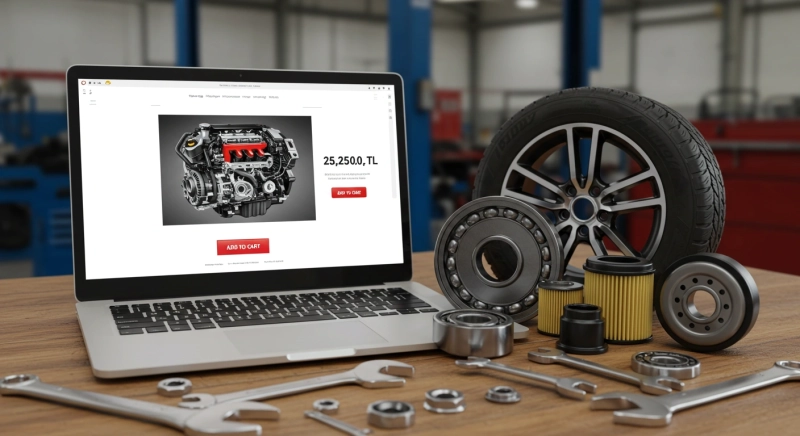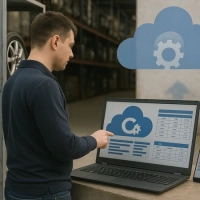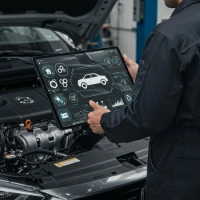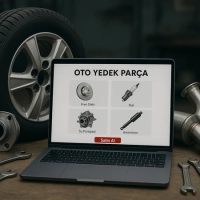
Automotive spare parts software are professional solutions that digitally optimize operations such as inventory management, order tracking, pricing and distribution of spare parts used in vehicle maintenance and repair processes.
Today, the automotive industry is increasingly recognizing the need for this software due to rapidly digitizing supply chains and rising customer expectations. For example, the global automotive spare parts market is expected to surpass $500 billion by 2025, with the adoption of digital management tools playing a significant role in this growth.
Automotive spare parts management is an extremely complex process due to thousands of different parts types, compatibility issues between models, and dynamic demand fluctuations. Manual systems for inventory tracking or order management can lead to wasted time and increased costs. With the proliferation of auto spare parts e-commerce, in particular, the automation and integration capabilities provided by these software programs have become critical to the industry.
In this article, we will examine in detail how automotive spare parts software provides advantages to businesses, what problems it solves, and the basic working principles of vehicle parts software technologies.
What is Automotive Spare Parts Software?

Automotive spare parts software are integrated solutions that combine operations such as inventory management, ordering processes, pricing and customer relations for spare parts manufacturers, distributors and sales points on a single digital platform.
The software mentioned increases business efficiency by integrating with ERP (Enterprise Resource Planning) systems, e-commerce platforms, and barcode scanning technologies. In the following sections, we will detail the key features of these software and which companies use them.
Definition and Basic Features
Automotive spare parts software primarily prevents issues such as overstocking or shortages by providing real-time tracking of parts inventory. For example, barcode integration allows for real-time recording and reporting of every part's movement within the warehouse. Furthermore, order tracking modules automatically process customer requests, monitor delivery processes, and identify potential delays in advance.
Another critical feature of the software is its dynamic pricing tools. It analyzes market demand fluctuations, competitor prices, and cost fluctuations to automatically update prices. This allows businesses using vehicle parts software to maintain profit margins and gain a competitive advantage.
Which Companies Use Automotive Spare Parts Software?
The types of companies that need to use automotive spare parts software are listed below with their descriptions.
- Automotive parts wholesalers: Due to their wide product range and high stock volume, they need automatic stock management and order integration.
- Authorized service centers: Customers prefer these software to quickly find parts suitable for their vehicles and speed up ordering processes.
- Distributors: Work with vehicle parts software to coordinate logistics between supplier and dealer networks.
- Auto spare parts e-commerce sites: Increase customer satisfaction by matching online orders with real-time stock information.
- Dealer chains: Used to centrally manage stocks in different locations and control pricing policies from a single source.
The companies listed above are reducing operational costs while increasing sales volume and customer loyalty thanks to automotive spare parts software. Digitalization, particularly in auto parts e-commerce processes, has become a key factor determining competitiveness in the sector.
What Problems Do Automotive Spare Parts Software Solve?
The automotive aftermarket industry faces numerous challenges due to operational complexity and rising customer expectations. Here are the key challenges and solutions these software solutions offer:
| Problem | Solution |
| Stock Confusion | Automotive spare parts software prevents parts in the warehouse from getting mixed up with real-time inventory tracking and barcode integration. |
| Pricing Errors | Dynamic pricing tools automate cost and competitor analysis, reducing the risk of incorrect pricing to zero. |
| Late Order Delivery | Automatic order tracking modules shorten delivery times by integrating supplier and logistics processes. |
| Customer Dissatisfaction | Vehicle parts software responds quickly to customer demands and improves the experience with personalized services. |
| Time Loss Due to Manual Processes | By automating all operations, it prevents human error and time loss in processes such as reporting, order processing and inventory management. |
| Lack of E-Commerce Integration | It synchronizes online sales channels with the central system by providing API integration with auto spare parts e-commerce platforms. |
The solutions described here make automotive spare parts software an indispensable part of the industry. For example, e-commerce sites for vehicle spare parts can instantly update inventory information with this software, reducing customer complaints by up to 40%. Similarly, by automating manual processes, businesses can double their operational efficiency.
In short, automotive aftermarket software reduces costs while strengthening critical assets like customer loyalty and brand reputation. Ignoring these technologies to stay ahead of the competition is no longer an option!
Basic Modules and Functions of the Software

Automotive spare parts software features core modules that integrate with each other to digitize business operations. Among these modules, inventory management, order and sales management, and current account and customer management are prominent. We'll detail how each module works and the benefits it offers businesses in the following sections.
Inventory Management
The inventory management module of automotive spare parts software tracks all parts in the warehouse in real time. Barcode integration records the incoming and outgoing parts in seconds, automatically updating stock levels. The system automatically sends a warning when predetermined minimum stock levels are reached, initiating the ordering process. This prevents issues such as running out of critical parts or unnecessary inventory buildup.
Vehicle parts software also allows you to manage inventory across different warehouse locations from a single dashboard. For example, a distributor can monitor parts movement in real-time between their Istanbul and Ankara warehouses.
Order and Sales Management
The order and sales management module automates all processes, from customer order creation to delivery. For example, when a customer orders an exhaust silencer from the online store, the system automatically checks stock availability and can list any alternative part suggestions. Once the order is confirmed, the invoice is automatically generated and integrated with the logistics company to initiate delivery tracking.
In the sales management section, monthly or annual sales reports are prepared to analyze which parts are in highest demand. This data is used to shape auto parts e-commerce strategies. All these processes are conducted through a single system, eliminating the need for manual intervention.
Current Account and Customer Management
The current account module simplifies tracking supplier and customer payments. For example, a dealer's debts to a distributor or customer overdue payments are automatically reported. The system helps manage cash flow by sending reminder emails when payment due dates are approaching.
On the customer management side, auto parts software offers personalized services like special pricing, discount coupons, or order history for customers. For example, if a special price is assigned to a frequent customer, this information is automatically reflected on the auto parts e-commerce site. This approach significantly increases customer loyalty and repeat sales.
Advantages of Using Automotive Spare Parts Software

Automotive spare parts software transforms both operational and financial processes for businesses. Here are the key benefits of using this software:
- Ease of spare parts tracking: Eliminates inventory confusion by tracking the stock status of thousands of parts in real time.
- Automatic stock update: Thanks to barcode integration and sensor technologies, stock levels are updated instantly, eliminating the need for manual data entry.
- Increased customer satisfaction: Fast order processing and accurate part delivery improves customer experience and increases repeat sales rates.
- Fast and error-free order management: Human errors are minimized with automatic order confirmation, invoice creation and logistics integration.
- Competitive advantage: Dynamic pricing and reporting tools allow you to quickly adapt to market trends and increase profitability.
- Auto spare parts e-commerce integration: Centralizes stock and order data by working in sync with online sales channels.
With these advantages, vehicle parts software helps businesses save both time and money while strengthening their brand reputation.
Industry Adaptability and Scalability
Automotive spare parts software is designed to meet the needs of companies of all sizes, from small businesses to large distribution companies. For example, a business with a single service point might start with basic inventory and ordering modules. As it grows, it can add modules for multiple warehouse management, e-commerce integration, or international supply chains.
One of the most striking examples of scalability is a small business that used vehicle parts software to grow into a regional dealership chain. The software centrally managed inventory across warehouses in different cities, standardized pricing policies, and increased online sales. This flexibility allows businesses to grow in tandem with technology.
Conclusion: Why Do You Need This Type of System?
The automotive aftermarket sector is experiencing a period where digitalization and automation are becoming essential. From inventory confusion and pricing errors to customer dissatisfaction and lost time, many issues are among the biggest obstacles facing businesses managed with manual processes. This is precisely where automotive aftermarket software comes in, consolidating operations on a single platform.
This software isn't limited to inventory tracking or order management. It offers businesses a "smart" infrastructure for everything from customer relations and e-commerce integration to dynamic pricing and multi-warehouse management. Its scalability, from a small service point to a nationwide distributor network, is a critical advantage for companies aiming for growth.
So, why do you still rely on paper-based systems or disjointed software in this rapidly competitive industry? Automotive spare parts software is an investment that minimizes errors, increases customer loyalty, and propels your business into the future. Embracing this technology is no longer a choice; it's a necessity for those who want to stay in the industry.
To learn more about the subject, you can also check out our content titled Auto Parts Software - Advantages and Importance .























